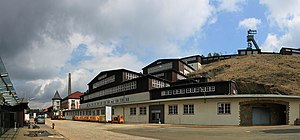Rammelsberg Mine
| Rammelsberg | |
|---|---|

Mining museum on the slopes of Rammelsberg
|
|
| Highest point | |
| Elevation | 635 m (2,083 ft) |
| Coordinates | 51°53′25″N 10°25′08″E / 51.89028°N 10.41889°ECoordinates: 51°53′25″N 10°25′08″E / 51.89028°N 10.41889°E |
| Geography | |
| Location | Lower Saxony, Germany |
| Parent range | Harz Mountains |
 |
|
| UNESCO World Heritage Site | |
|---|---|
| Official name | Mines of Rammelsberg, Historic Town of Goslar and Upper Harz Water Management System |
| Location |
Harz, Germany |
| Coordinates | 51°53′15″N 10°25′54″E / 51.8875°N 10.4317°E |
| Criteria | Cultural: i, iv |
| Reference | 623 |
| Inscription | 1992 (16th Session) |
| Extensions | 2010 |
|
[]
|
|
The Rammelsberg is a mountain, 635 metres (2,083 ft) high, on the northern edge of the Harz range, south of the historic town of Goslar in the North German state of Lower Saxony. The mountain is the location of an important silver, copper, and lead mine, the only mine which had been working continuously for over 1,000 years when it finally closed in 1988. Since 1992, the visitor mine of Rammelsberg has become a UNESCO World heritage site.
According to legend, the mountain was named after a knight called "Ramm", who was a henchman of Emperor Otto the Great. In 968, whilst out hunting, the knight tied his horse to a tree, in order to pursue some deer through almost impassable terrain. His charger impatiently pawed the ground with its hooves whilst waiting for his master to return and so exposed a vein of silver ore. According to another explanations, the name may be derived from the widespread ramsons (Low German: Ramsen) found on the slopes. It is most probably however, that "ram" is a very old word-explanation for "ore with copper". In Italian today "rame" means "copper".
Unlike the mineral deposits of the Upper Harz, the ore deposits at the Rammelsberg were caused by the escape of hot, metal-bearing, thermal springs on the sea floor in the Devonian period. This formation is referred to as a sedimentary exhalative deposit. At the bottom of the Devonian sea, two large lenses of ore were formed that were later caught up in the folding of rocks during the Carboniferous period and so lie overturned at an angle in the mountain.
...
Wikipedia


